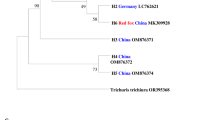Summary
In order to develop a standard technique for in vivo labelling of Schistosoma mansoni and S. intercalatum cercariae by incubation of infected host snails with radioselenium, studies were conducted on the relationship between mode of administration, dose size (μCi), and time of administration of the radioisotope on the one hand and the production of cercariae and the amount of cercaria-bound radioactivity obtained on the other.
The ability to take up radioactivity by B. glabrata snails was influenced by the following factors: living/heat-killed snails, size of snails, length of exposure period, volume of exposure medium, and the amount of radioactivity per snail in the exposure medium. A linear proportionality existed between the amount of radioactivity in the exposure medium and the subsequent snail-bound radioactivity. The rate of uptake and the final level of snail-bound radioactivity reached was increased by reducing the volume of the exposure medium to a minimum. Thus, at exposure to 75Se-methionine in 1 ml exposure medium the maximum snail-bound radioactivity (70–85% of available amount) was obtained after 5 h. Therefore, the labelling procedure used comprised an individual exposure of snails in 1 ml for 20 h to radioselenium. Irrespective of the exposure level (μCi) used the labelling of infected B. glabrata prior to or 3 days after the start of shedding of cercariae resulted in a significant interference with the production of cercariae. The same interference was observed when snails were labelled 12 days after patency using exposure levels at or above 6.6 μCi/snail. However, a dose level of or below 5.5 μCi/snail administered 12 days after the start of shedding cercariae did not interfere with the host-parasite relationship, i.e. a normal and continuous production of labelled cercariae was obtained during a period of at least 54 days.
The maximum cercaria-bound radioactivity obtained, using non-influential dose levels, was obtained 3 days after exposure of snails to the isotope. The maximum amount obtained was roughly comparable when exposure levels of 3.0–19.5 μCi per snail were used after the start of shedding of cercariae.
The labelling procedure did not interfere with the biological characteristics of the labelled larvae. Thus their behavioural activity, longevity, and infectivity to mice were comparable with those of unlabelled cercariae.
The possible application of labelled larval schistosomes to various problems in research on schistosomiasis is discussed.
Similar content being viewed by others
References
Bruce, J.I., Weiss, E., Stirewalt, M.A., Lincicome, D.R.: Schistosoma mansoni glycogen content and utilization of glucose, pyrovate, glutamate, and citric acid cycle intermediates by cercariae and schistosomules. Exp. Parasitol. 26, 29–40 (1969)
Christensen, N.Ø., Frandsen, F., Nansen, P.: A method for in vivo labelling of schistosome miracidia with radioselenium. J. Parasitol. 63, 165–166 (1977a)
Christensen, N.Ø., Frandsen, F., Nansen, P.: Host-finding capacity of schistosome cercariae. Comparative efficiency of methods of mouse infection and a radioisotope assay system for cercarial host-finding. J. Helminthol. 51, 105–113 (1977b)
Knight, W.B., Liard, F., Ritchie, L.S., Pellegrino, J., Chiriboga, J.: Labelling of Biomphalaria glabrata and cercariae of Schistosoma mansoni with radioselenium. Exp. Parasitol. 22, 309–315 (1968)
Lewert, R.M., Para, B.J.: The physiological incorporation of carbon 14 in Schistosoma mansoni cercariae. J. Infect. Dis. 116, 171–82 (1966)
Nansen, P., Christensen. N.Ø., Frandsen, F.: A technique for in vivo labelling of Fasciola hepatica miracidia with radioselenium. Z. Parasitenkd. 49, 73–80 (1976a)
Nansen, P., Frandsen, F., Christensen, N.Ø.: A study on snail location by Fasciola hepatica using radioisotopically labelled miracidia. Parasitology 72, 163–171 (1976b)
Olivier, L., Stirewalt, M.A.: An efficient method for exposure of mice to cercariae of Schistosoma mansoni. J. Parasitol. 38, 19–23 (1952)
Author information
Authors and Affiliations
Rights and permissions
About this article
Cite this article
Christensen, N.Ø. A method for the in vivo labelling of Schistosoma mansoni and S. intercalatum cercariae with radioselenium. Z. F. Parasitenkunde 54, 275–288 (1977). https://doi.org/10.1007/BF00390119
Received:
Issue Date:
DOI: https://doi.org/10.1007/BF00390119




